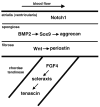Heart valve development: regulatory networks in development and disease
- PMID: 19713546
- PMCID: PMC2777683
- DOI: 10.1161/CIRCRESAHA.109.201566
Heart valve development: regulatory networks in development and disease
Abstract
In recent years, significant advances have been made in the definition of regulatory pathways that control normal and abnormal cardiac valve development. Here, we review the cellular and molecular mechanisms underlying the early development of valve progenitors and establishment of normal valve structure and function. Regulatory hierarchies consisting of a variety of signaling pathways, transcription factors, and downstream structural genes are conserved during vertebrate valvulogenesis. Complex intersecting regulatory pathways are required for endocardial cushion formation, valve progenitor cell proliferation, valve cell lineage development, and establishment of extracellular matrix compartments in the stratified valve leaflets. There is increasing evidence that the regulatory mechanisms governing normal valve development also contribute to human valve pathology. In addition, congenital valve malformations are predominant among diseased valves replaced late in life. The understanding of valve developmental mechanisms has important implications in the diagnosis and management of congenital and adult valve disease.
Figures




References
-
- Hoffman JIE, Kaplan S. The incidence of congenital heart disease. J Am Coll Cardiol. 2002;39:1890–1900. - PubMed
-
- Pierpont ME, Basson CT, Benson DW, Jr, Gelb BD, Giglia TM, Goldmuntz E, McGee G, Sable CA, Srivastava D, Webb CL. Genetic basis for congenital heart defects: current knowledge: a scientific statement from the American Heart Association Congenital Cardiac Defects Committee, Council on Cardiovascular Disease in the Young. Circulation. 2007;115:3015–3038. - PubMed
-
- Supino PG, Borer JS, Yin A, Dillingham E, McClymont W. The epidemiology of valvular heart diseases: the problem is growing. Adv Cardiol. 2004;41:9–15. - PubMed
-
- Roberts WC, Ko JM. Frequency by decades of unicuspid, bicuspid and tricuspid aortic valves in adults having isolated aortic valve replacement for aortic stenosis, with or without associated aortic regurgitation. Circulation. 2005;111:920–925. - PubMed
-
- Weismann CG, Gelb BD. The genetics of congenital heart disease: a review of recent developments. Curr Opin Cardiol. 2007;22:200–206. - PubMed
Publication types
MeSH terms
Grants and funding
LinkOut - more resources
Full Text Sources
Other Literature Sources
Medical

